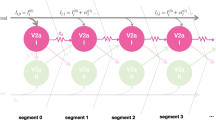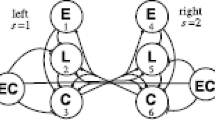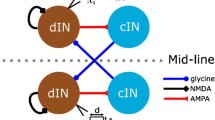Abstract
The neuronal circuits that generate swimming movements in the leech were simulated by a chain of coupled harmonic oscillators. Our model incorporates a gradient of rostrocaudally decreasing cycle periods along the oscillator chain, a finite conduction delay for coupling signals, and multiple coupling channels connecting each pair of oscillators. The interactions mediated by these channels are characterized by sinusoidal phase response curves. Investigations of this model were carried out with the aid of a digital computer and the results of a variety of manipulations were compared with data from analogous physiological experiments. The simulations reproduced many aspects of intersegmental coordination in the leech, including the findings that: 1) phase lags between adjacent ganglia are larger near the caudal than the rostral end of the leech nerve cord; 2) intersegmental phase lags increase as the number of ganglia in nervecord preparations is reduced; 3) severing one of the paired lateral connective nerves can reverse the phase lag across the lesion and 4) blocking synaptic transmission in midganglia of the ventral nerve cord reduces phase lags across the block.
Similar content being viewed by others
References
Cohen AH, Holmes PJ, Rand RH (1982) The nature of the coupling between segmental oscillators of the lamprey spinal generator for locomotion: a mathematical model. J Math Biol 13:345–369
Friesen WO (1985a) Neuronal control of leech swimming movements: interactions between cell 60 and previously described oscillator neurons. J Comp Physiol A 156:231–242
Friesen WO (1985b) Inhibitory motor neurons are part of the network which generates the leech (Hirudo) swimming activity. Soc Neurosci 10:148 (abstr)
Friesen WO, Stent GS (1977) Generation of a locomotory rhythm by a neural network with recurrent cyclic inhibition. Biol Cybern 28:27–40
Friesen WO, Poon M, Stent GS (1978) Neuronal control of swimming in the medicinal leech. IV. Identification of a network of oscillatory interneurons. J Exp Biol 75:25–43
Ikeda K, Wiersma, CAG (1964) Autogenic rhythmicity in the abdominal ganglion of the crayfish: the control of swimmeret movements. Comp Biochem Physiol 12:107–115
Kopell N (1985) Coupled oscillators and locomotion by fish. In: Othmer H (ed) Nonlinear Oscillations in Chemistry and Biology. Springer, Berlin Heidelberg New York
Kopell N, Ermentrout B (1986) Symmetry and phase locking in chains of weakly coupled oscillators. In: Communication in Pure and Applied Mathematics. Wiley, New York (in press)
Kristan WB Jr, Calabrese RL (1976) Rhythmic swimming activity in neurones of the isolated nerve cord of the leech. J Exp Biol 65:643–668
Pavlidis T (1973) Biological Oscillators: Their Mathematical Analysis. Academic Press, New York
Pearce RA, Friesen WO (1984) Intersegmental coordination of leech swimming: comparison of in situ and isolated nerve cord activity with body wall movement. Brain Res 299:363–366
Pearce RA, Friesen WO (1985a) Intersegmental coordination of the leech swimming rhythm. I. Intrinsic period gradient and coupling strength. J Neurophysiol 54:1444–1458
Pearce RA, Friesen WO (1985b) Intersegmental coordination of the leech swimming rhythm. II. Comparison of long and short chains of ganglia. J Neurophysiol 54:1460–1472
Pinsker HM, Ayers J (1983) Neuronal oscillators. In: Willis WD (ed) The Clinical Neurosciences. Neurobiology. Churchill Livingstone, New York
Poon M, Friesen WO, Stent GS (1978) Neuronal control of swimming in the medicinal leech. V. Connections between the oscillatory interneurons and the motor neurons. J Exp Biol 75:45–63
Roberts A, Roberts BL (1983) Neural Origin of Rhythmic Movements. Cambridge University Press, Cambridge
Stein PSG (1976) Mechanisms of interlimb phase control. In: Herman RM, Grillner S, Stein PSG, Stuart DG (eds) Neural Control of Locomotion. Plenum Press, New York
Stein PSG (1977) Application of the mathematics of coupled oscillator systems to the analysis of the neural control of locomotion. Fed Proc 36:2056–2059
Weeks JC (1981) Neuronal basis of leech swimming: separation of swim initiation, pattern generation, and intersegmental coordination by selective lesions. J Neurophysiol 45:698–723
Weeks JC (1982) Synaptic basis of swim initiation in the leech. II. A pattern-generating neuron (cell 208) which mediates motor effects of swim-initiating neurons. J Comp Physiol 148:265–279
Author information
Authors and Affiliations
Rights and permissions
About this article
Cite this article
Pearce, R.A., Friesen, W.O. A model for intersegmental coordination in the leech nerve cord. Biol. Cybern. 58, 301–311 (1988). https://doi.org/10.1007/BF00363939
Received:
Accepted:
Issue Date:
DOI: https://doi.org/10.1007/BF00363939




